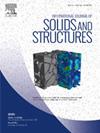Deformation-dependent effective mobility in Structural Battery Electrolytes
IF 3.4
3区 工程技术
Q1 MECHANICS
International Journal of Solids and Structures
Pub Date : 2025-03-28
DOI:10.1016/j.ijsolstr.2025.113342
引用次数: 0
Abstract
This paper considers chemical diffusion in a Structural Battery Electrolyte (SBE) under the influence of finite deformation, which serves as a first step towards the more rigorous electro-chemically coupled modeling of deformation-dependent ionic transport in SBEs. The SBE is a porous (bicontinuous) microstructure consisting of a solid (polymer) skeleton, and pores filled with a liquid electrolyte. We present a variationally consistent computational homogenization scheme and exploit 3D-representation of the microstructure to compute the deformation-dependent effective mobility via direct upscaling in a two-step procedure (sequentially coupled approach). The pertinent RVE problem is established for the mechanical (equilibrium) problem under macro-scale deformation control, while adopting Neo-Hooke hyperelasticity for the fine-scale modeling of the solid skeleton. Thereby, the elastic moduli are calibrated based on experimental data for the effective response. Subsequently, Fickian diffusion, with a constant mobility in the liquid electrolyte is considered in the deformed pore space. Exploiting a pull-back to the reference configuration, we avoid remeshing while still incorporating the necessary pore space deformation. By adopting a suitable constitutive model for the fictitious solid in the pore space, we also prevent self-penetration of the solid skeleton during deformation, which mimics contact behavior without explicitly solving a computationally expensive contact problem involving contact search. Upon homogenizing the local ionic flux, we obtain the effective mobility pertaining to the macro-scale chemical potential gradient, while noting that the RVE-problem is linear in the chemical potential for a given macro-scale deformation gradient. The numerical results show that when the macro-scale loading is of compressive type, the pore volume is reduced and, as a direct consequence, the effective mobility becomes smaller. In essence, the framework can track the geometrically induced anisotropy of the RVE under mechanical loading, corresponding to a change in the computational domain for the transport problem, thereby influencing the ionic flux. E.g. for a bicontinuous SBE with 37% initial porosity and an externally applied macroscopic compression of 20% strain, we could observe up to 26% reduction in the effective mobility components.
结构电池电解质中变形相关的有效迁移率
本文考虑了有限变形影响下结构电池电解质(SBE)中的化学扩散,这是SBE中变形相关离子传输的更严格的电化学耦合建模的第一步。SBE是一种多孔(双连续)微观结构,由固体(聚合物)骨架和充满液体电解质的孔隙组成。我们提出了一种变化一致的计算均匀化方案,并利用微观结构的3d表示,通过两步程序(顺序耦合方法)的直接升级来计算变形相关的有效迁移率。针对宏观尺度变形控制下的力学(平衡)问题,建立了相应的RVE问题,并采用Neo-Hooke超弹性模型对实体骨架进行了精细尺度建模。因此,根据有效响应的实验数据对弹性模量进行了校准。随后,考虑了液体电解质在变形孔隙空间中具有恒定迁移率的菲克扩散。利用回拉到参考配置,我们避免了重新划分网格,同时仍然考虑了必要的孔隙空间变形。通过对孔隙空间中的虚拟实体采用合适的本构模型,我们还防止了变形过程中实体骨架的自渗透,这模拟了接触行为,而没有明确解决涉及接触搜索的计算昂贵的接触问题。在均匀化局部离子通量后,我们得到了宏观尺度化学势梯度下的有效迁移率,同时注意到rve问题在给定宏观尺度变形梯度下的化学势是线性的。数值结果表明,当宏观加载为压缩加载时,孔隙体积减小,有效迁移率减小。本质上,该框架可以跟踪RVE在机械载荷下的几何诱导各向异性,对应于输运问题计算域的变化,从而影响离子通量。例如,对于具有37%初始孔隙率和20%外部施加宏观压缩应变的双连续SBE,我们可以观察到有效迁移率成分减少高达26%。
本文章由计算机程序翻译,如有差异,请以英文原文为准。
求助全文
约1分钟内获得全文
求助全文
来源期刊
CiteScore
6.70
自引率
8.30%
发文量
405
审稿时长
70 days
期刊介绍:
The International Journal of Solids and Structures has as its objective the publication and dissemination of original research in Mechanics of Solids and Structures as a field of Applied Science and Engineering. It fosters thus the exchange of ideas among workers in different parts of the world and also among workers who emphasize different aspects of the foundations and applications of the field.
Standing as it does at the cross-roads of Materials Science, Life Sciences, Mathematics, Physics and Engineering Design, the Mechanics of Solids and Structures is experiencing considerable growth as a result of recent technological advances. The Journal, by providing an international medium of communication, is encouraging this growth and is encompassing all aspects of the field from the more classical problems of structural analysis to mechanics of solids continually interacting with other media and including fracture, flow, wave propagation, heat transfer, thermal effects in solids, optimum design methods, model analysis, structural topology and numerical techniques. Interest extends to both inorganic and organic solids and structures.

 求助内容:
求助内容: 应助结果提醒方式:
应助结果提醒方式:


